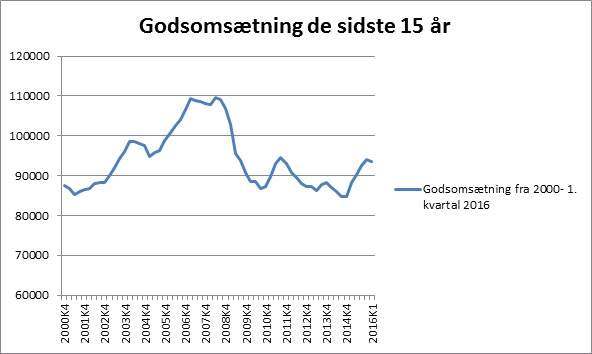Godsomsætning i havne står i stampe

”De spæde tegn på stigende godsmængder gennem 2015 er afløst af fornyet afmatning. De danske havne lider derfor forsat under efterveerne fra finanskrisen på godsområdet.” Det siger Bjørn B. Christiansen, direktør i Danske Havne, på baggrund af havnenes godsomsætning for hele 2015, som netop er offentliggjort af Danmarks Statistik. ”Det er tankevækkende og bør give anledning til, at havnene er særligt opmærksomme på, at større investeringer i havneudvidelser og kajanlæg ikke kan basere sig på stigende godsmængder generelt. Derfor ser vi også, at havnene i disse år gennemfører investeringer, som retter sig mod mange andre områder end netop godsområdet”, siger direktøren for Danske Havne. ”Der opbygges nye klynger og forretningsområder, og det bidrager alt sammen til en mindre risiko og eksponering over for et godsområde, der har så svært ved at vokse”, siger Bjørn B. Christiansen. Mere gods ad søvejen og større konkurrencekraft er løsningen Hvordan skal stilstanden vendes? I Vækstteam for Det Blå Danmark, nedsat af erhvervs- og vækstminister Troels Lund Poulsen, er der netop fokus på at få mere gods ad søvejen. Det nationale fokus følger i slipstrømmen på EU’s målsætning om, at 30 procent mere gods skal ad søvejen eller på bane inden 2030. Det er en gammel sag, men mon ikke de svigtende godsmængder kan få os alle sammen til at give vejnettet en tiltrængt hjælpende hånd, og få sat skub i overflytningen fra vej til sø. Vi har trængsel på vejnettet, og overskudskapacitet i havene og på søvejene. For nærmere information kontakt venligst: Bjørn B. Christiansen, direktør Danske Havne: 25 37 03 64  Kilde: Danmarks Statistik. SKIB72: Godsomsætning på større danske havne efter havn, retning og godsart på kvartals-niveau. (angivet i 1.000 ton) ANM: Data er beregnet som en rullende sum af de seneste 4 kvartaler på baggrund af kvartalsdata for de store havne opregnet til godomsætning for alle havne
Kilde: Danmarks Statistik. SKIB72: Godsomsætning på større danske havne efter havn, retning og godsart på kvartals-niveau. (angivet i 1.000 ton) ANM: Data er beregnet som en rullende sum af de seneste 4 kvartaler på baggrund af kvartalsdata for de store havne opregnet til godomsætning for alle havne
